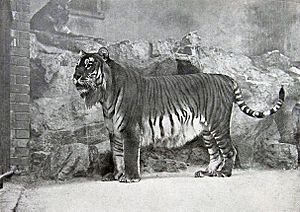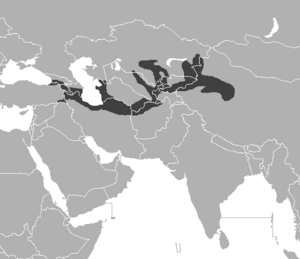Caspian tiger facts for kids
Quick facts for kids Caspian tiger |
|
|---|---|
 |
|
| Captive Caspian tiger, Berlin Zoo, 1899 | |
| Conservation status | |
| Scientific classification | |
| Kingdom: | |
| Phylum: | |
| Class: | |
| Order: | |
| Family: | |
| Subfamily: | |
| Genus: | |
| Species: | |
| Subspecies: |
P. t. virgata
|
| Trinomial name | |
| Panthera tigris virgata Illiger, 1815
|
|
 |
|
| Original distribution (in dark grey) | |
The Caspian tiger (Panthera tigris virgata) was a type of tiger that is now extinct. It was also known by other names like the Hyrcanian tiger, Mazandaran tiger, Persian tiger, and Turan tiger. These amazing big cats lived in the wild until the early 1970s. They used to roam in forests and along rivers west and south of the Caspian Sea. Their home stretched from Turkey and Iran all the way east through Central Asia to the Takla Makan desert in Xinjiang, China. Sadly, there are no Caspian tigers left alive, not even in zoos.
Caspian tigers were once found in many countries. This included parts of Chinese and Russian Turkestan, Afghanistan, Iran, and Turkey. Along with the Siberian tiger and Bengal tiger, the Caspian tiger was one of the largest big cats to ever live.
Contents
What Made Caspian Tigers Special?
Size and Appearance

Caspian tigers were generally a bit smaller than Siberian tigers. Male Caspian tigers in Turkestan could be over 200 centimeters (about 6.5 feet) long. Some were even recorded at 270 centimeters (nearly 9 feet)! Female tigers were smaller, usually between 160 to 180 centimeters (about 5 to 6 feet) long. The heaviest Caspian tiger known weighed about 240 kilograms (530 pounds).
Fur and Stripes
The fur of the Caspian tiger was usually a bright, even color. Its stripes were thinner and closer together than those of the Siberian tiger. These stripes were a mix of brown or cinnamon colors. Only on their head, neck, middle of the back, and tail tip were the stripes pure black.
Their fur looked different in summer and winter. The winter coat was lighter with less clear stripes. The summer coat was similar to a Bengal tiger's fur, but its stripes were usually narrower and longer.
Family Tree: Caspian and Siberian Tigers
Scientists have studied the genes of Caspian tigers. They found that the Amur tiger is the closest living relative of the extinct Caspian tiger. This means they shared a very recent ancestor.
Researchers believe that the ancestors of both Caspian and Amur tigers came from eastern China. They traveled through Central Asia along the Silk Road less than 10,000 years ago. Then, they moved eastward into Siberia, where the Amur tiger now lives. Human activities during the Industrial Revolution likely separated these two groups, which were probably once a single large population.
Where Caspian Tigers Lived
Caspian tigers did not live everywhere in the Caspian Sea region. They preferred areas with water, like rivers, lakes, and their edges. In the 1800s, they were found in:
- The southeastern Caucasus mountains, in forests and lowlands.
- Parts of Central Asia, along rivers like the Atrek River, Amu-Darya, and Syr-Darya.
- Around the Aral Sea and Lake Balkhash.
Their homes were often narrow strips of land, just a few kilometers wide. These areas had enough prey for them.
Caspian tigers lived where their prey lived. Wild pigs were a very common food source. They lived in forests, along rivers, and in thick bushes. Red deer and roe deer were also found in forests around the Black Sea and the southern Caspian Sea. Other deer species like Bactrian deer and Manchurian wapiti were also part of their diet in different areas.
What Caspian Tigers Ate
Scientists don't have much information about how much land a Caspian tiger needed. But they know these tigers had to travel far to find food. Their main food was wild pigs and deer. In many parts of Central Asia, Bactrian deer and roe deer were important prey.
Sometimes, they also hunted other animals like goitered gazelles, jackals, and smaller mammals. In some areas, they even hunted saiga (a type of antelope), wild horses, and mountain sheep. They would follow herds of migratory animals like reindeer. They even caught fish in flooded areas! In winter, they sometimes attacked dogs and farm animals that wandered away. They preferred to drink water from rivers.
Why Caspian Tigers Disappeared
The Caspian tiger started to disappear when Russians began settling in Turkestan in the late 1800s. Several things led to their extinction:
- Hunting: Many people, including hunters and soldiers, hunted wild pigs and tigers without thinking about the future.
- Habitat Loss: The tall reed beds where tigers lived were turned into farmland. People grew crops like cotton along the rivers. This destroyed the tigers' homes.
- Prey Loss: The number of wild pigs and deer dropped a lot. This was due to too much hunting, natural disasters like floods and fires, and diseases like swine fever.
- Vulnerable Location: Tigers were already at risk because they lived in narrow strips of habitat along rivers, surrounded by vast deserts.
In the early 1900s, the Russian army was even used to clear predators like tigers from forests and around settlements. People were paid a lot of money for tiger skins until 1929. As more people moved into the areas and farming grew, the tigers' food sources (wild pigs and deer) were also hunted too much.
The Last Caspian Tigers
The last known Caspian tiger in Iraq was killed in 1887. In the Caucasus region, the last tiger was killed in 1922 near Tbilisi, Georgia. They disappeared from the Tarim River basin in Xinjiang, China, in the 1920s.
In Kazakhstan, the last tiger was seen in 1948 near the Ili River. In Turkmenistan, the last tiger was killed in January 1954. In Iran, one of the last tigers was shot in 1953, and one was sighted in 1958. In China's Tian Shan mountains, the last Caspian tigers disappeared in the 1960s. An unconfirmed sighting near Nukus in 1968 was the last record from the lower Amu-Darya river. By the early 1970s, tigers were gone from these areas.
There are reports of a tiger being killed in Turkey in 1970. Some surveys suggest tigers might have survived in eastern Turkey until the early 1990s, but no further studies were done.
Efforts to Save Them
In 1938, the first protected area for tigers was created in Tajikistan. It was called Tigrovaya Balka, which means "tiger former river channel." This area was the last place Caspian tigers lived in the Soviet Union. The last Caspian tiger there was seen in 1958.
Since 1947, Caspian tigers were legally protected in the USSR. In Iran, they were protected starting in 1957, with big fines for hunting them. However, by the early 1970s, biologists searched for Caspian tigers in Iran's forests but found no signs of them.
Could Tigers Return to Central Asia?
Because the Amur tiger is so similar to the Caspian tiger, people have discussed bringing Amur tigers to safe places in Central Asia. The Amu-Darya Delta was suggested as a possible location.
However, a study found that a healthy tiger population of about 100 animals would need at least 5,000 square kilometers (about 1,930 square miles) of connected habitat with lots of prey. This kind of habitat is not available right now. So, this area is not suitable for bringing tigers back, at least not yet.
Even though bringing back the Caspian tiger has been discussed, the specific locations for the tigers still need more planning. But early studies show that some small areas in Central Asia still have natural habitats that could be good for tigers.
Images for kids
-
Mosaic of an elephant attacking a tiger, from Roman Syria, which occupied parts of what is now Anatolia and Mesopotamia
See also
 In Spanish: Tigre persa para niños
In Spanish: Tigre persa para niños





